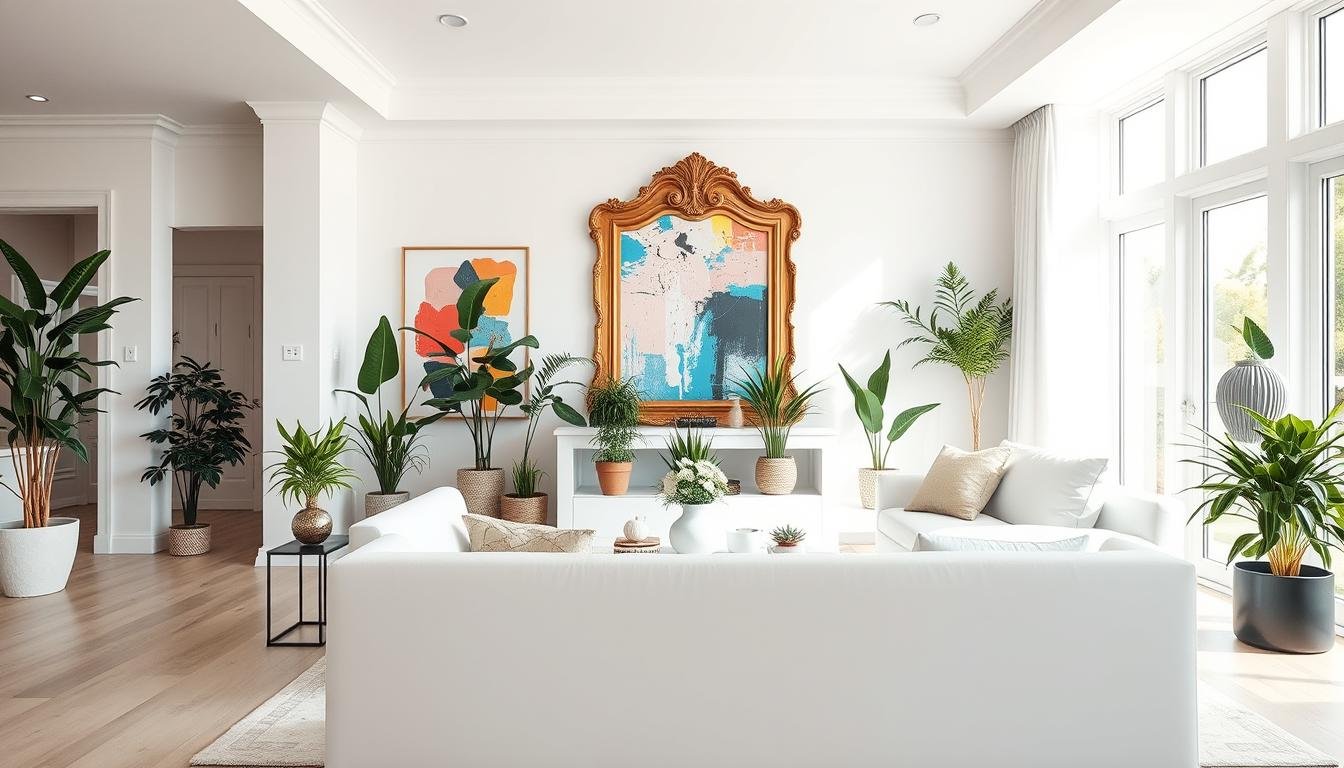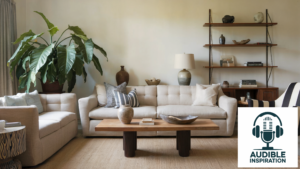Choosing a home decor style is important. It should mirror your personality, lifestyle, and taste. Minimalist and maximalist styles stand out the most. Minimalism is about keeping it simple and functional, aiming for a clutter-free space. On the other hand, maximalism goes for bold and colorful looks, filling rooms with eye-catching wallpaper.
Minimalism uses neutral colors, like whites and browns, to create calm spaces. Maximalist decor, however, loves bright colors, patterns, and textures. It makes rooms feel vibrant and full of life. Knowing these key differences can help you pick the style that fits you best.
An Introduction to Minimalist and Maximalist Home Decor
When exploring home decor, you’ll find two main styles: Minimalism and Maximalism. They each have their unique principles, fitting different tastes and ways of life.
Minimalism follows the “less is more” idea, focusing on simplicity and function. It features neutral shades like white and light gray, keeping spaces clean and calm. Essentials in a minimalist space are both useful and nice to look at, such as sleek furniture. Items like Amish-crafted pieces fit well because of their simple, quality design. Choosing this style means enjoying a peaceful, airy space.
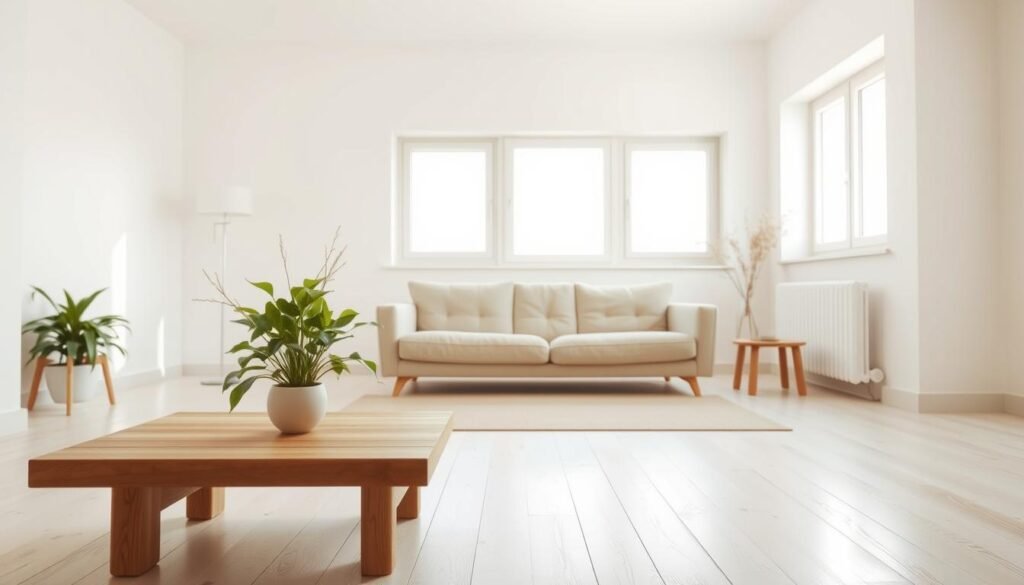
Maximalism, however, believes in “more is more”, celebrating lots of colors and personal style. It loves bold colors, like deep blues, and mixing various furniture looks. This style fills rooms with many accessories that tell stories, making spaces full of life. Maximalist decor shows off personality and creativity, creating lively, cozy spaces.
Both minimalist and maximalist styles have their perks. If you prefer things simple and tidy, minimalism might be for you. But if you love being surrounded by colors and patterns, maximalism could be more your style. Knowing what each offers helps you pick the right one for your home.
The Origins of Minimalism
Minimalism started after World War II, mostly in Western art and music. The term got popular in the 1960s among young artists. They wanted to make art simple and functional, unlike the busy life of the mid-20th century.
The Influence of Japanese and Scandinavian Design
Japanese and Scandinavian designs greatly shaped minimalism. They focus on simplicity and natural beauty. The Japanese concept of ‘Ma’ values empty spaces for peace and order.
Scandinavian design loves practicality and subtle elegance. It uses light colors and natural materials. This creates welcoming and simple spaces. These designs keep inspiring minimalist homes, mixing beauty with function.
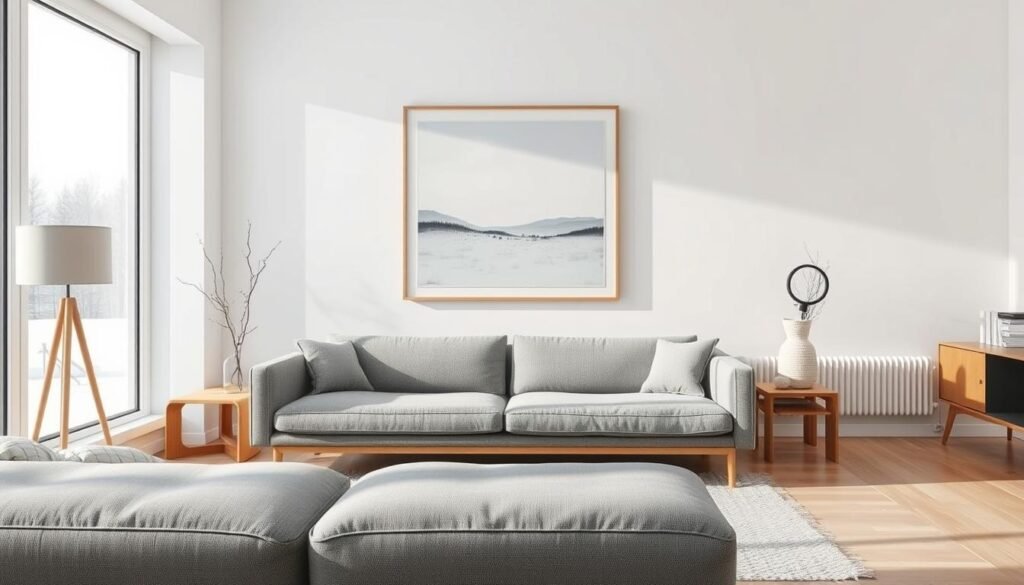
The Mid-20th Century Minimalist Art Movement
The minimalist art movement was a change from the complex Abstract Expressionism. Artists like Donald Judd and Frank Stella used simple shapes and limited colors. They wanted art to be about its true essence.
They worked with materials like metal and concrete. Their creations were simple but impactful. This style affected music, literature, and architecture too, focusing on simplicity and the core of the work.
Key Characteristics of Minimalism
Minimalism stands for simplicity and beauty. It loves the idea that “less is more.” By cutting down furniture by about 30%, it makes a space calm and more useful. About 60% of people like this style because it keeps their living area tidy. This helps them feel peaceful and relaxed.
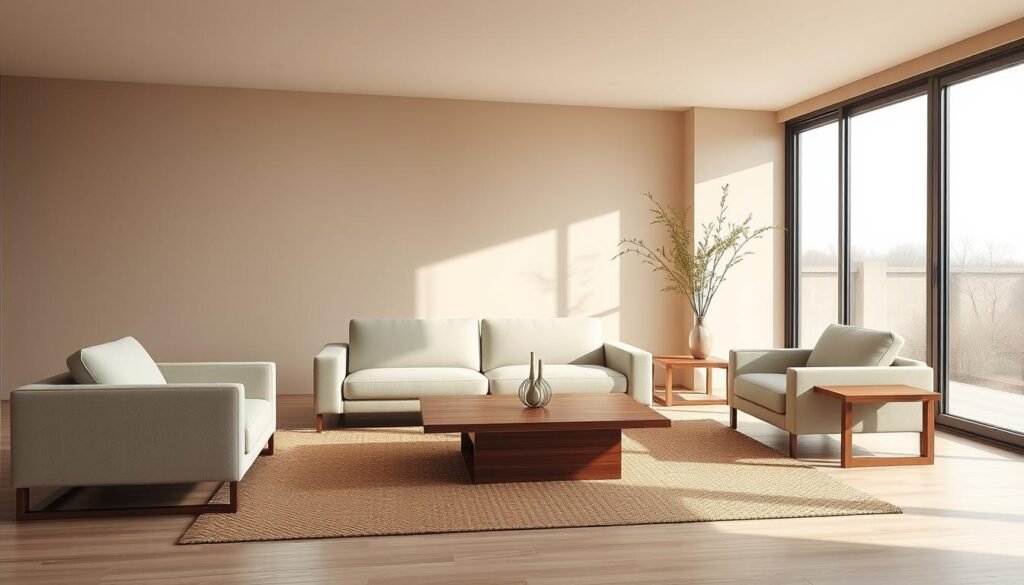
Clean Lines and Simple Forms
Minimalism loves clean lines and simple shapes. It makes sure every furniture piece has a purpose. You get a space that’s easy to understand and useful. This way, it feels larger and free from clutter, bringing peace and order.
Neutral Color Palette
Most minimalist homes incorporate calm colors like whites, beiges, and greys, creating a soothing atmosphere. These shades help promote relaxation and a sense of tranquility. Adding various textures, such as linen or wool, brings warmth and depth to the space while maintaining a simple aesthetic. A cohesive color palette ties the minimalist look together seamlessly.r.
Open and Decluttered Spaces
Open spaces are essential in minimalism, allowing more natural light to flow in compared to cluttered designs. This is due to open layouts and fewer decorations, creating a bright and airy atmosphere. Removing unnecessary items also makes the space feel larger and more peaceful. Many people living in minimalist homes report feeling less stressed, highlighting how this design promotes a sense of calm and mental clarity.
Modern Minimalism in Home Decor
Modern minimalism in home decor focuses on simplicity, usefulness, and natural parts. This style makes living spaces calm and not too busy. By choosing practical design over fancy looks, you can make any room both useful and fashionable.
Function Over Form
Modern minimalist decor values practicality above ornate design. It emphasizes using space well, not just looking good. The Scandinavian style shows this by loving natural light and tidy spaces. In kitchens, flat-panel cabinets and open shelves let in light, making the area feel bigger and stylish.
Neutral Colors and Natural Materials
Neutral colors are key in modern minimalist design, with whites, grays, and beiges leading. These colors make a peaceful setting that’s easy to add personality to with colors and textures. Using natural stuff like stone, light wood, and wool keeps the minimalist look warm and inviting.
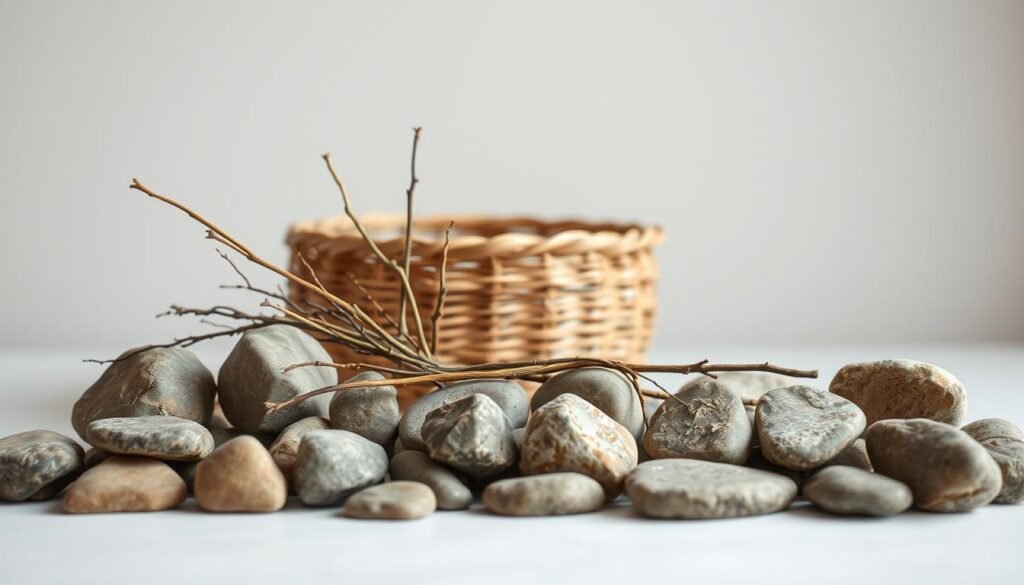
Minimalist Furniture Choices
In a minimalist home, furniture is all about simple design and being useful. Mixing quality items from various times adds interest without mess. Built-in shelves that match the wall color keep things neat. Choose furniture that uses both industrial and classic materials to mix modern and natural vibes well.
Choosing modern decor that blends simple design with natural elements makes your home both cool and comfy to live in.
The Origins of Maximalism
Maximalism has become more popular lately, especially with people being home more during the pandemic. They’ve turned to bold and varied designs. Maximalism’s roots go way back, showing a deep history of design.
Historical Influences and Inspirations
The idea of maximalist decor started in the Baroque style, made famous by French King Louis XIV. Think of the opulent designs in the Palace of Versailles as examples. Maximalism also grew during the Victorian era. Then, middle-class families had more money to spend thanks to the industrial revolution.
They filled their homes with lots of stuff, showing off their wealth through their possessions. This reflects how people viewed material things back then.
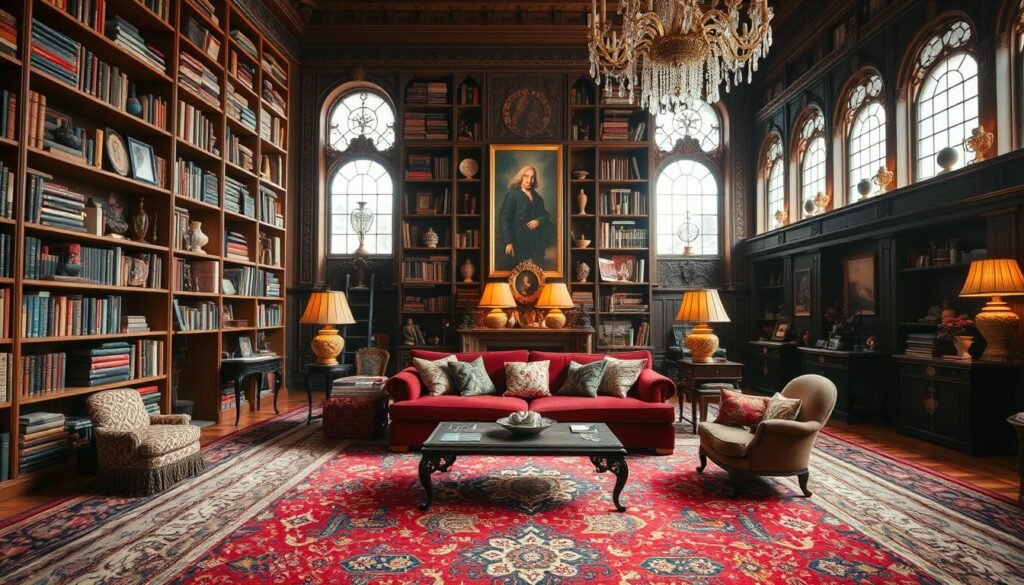
The Evolution of Maximalist Design Styles
The popularity of maximalism has changed over time, sometimes more favored and sometimes less. Key figures like Dorothy Draper in the 1960s and Henri Samuel in the 1980s added to its appeal. They mixed different styles with history to create eye-catching, lively spaces.
Today, maximalism uses bright colors and striking patterns more than ever. This makes it appealing to a broader range of people. The design world is talking about maximalism more and more. This shows people like its bold, expressive styles.
Designers like Kelly Wearstler and Martin Brudnizki have helped make maximalism popular. The debate between maximalism and minimalism in design shows how diverse our tastes in decorating are.
Key Characteristics of Maximalism
Maximalism pops with its bright use of colors, patterns, and textures. It makes rooms full of life and interest. This style mixes bold home accents, unique decor, and personal collectibles. Let’s explore how to bring this look into your home.
Vibrant Colors and Patterns
At its heart, maximalism loves bold, vibrant colors and patterns. Picture deep emerald green, bright sapphire blue, and intense ruby red. These colors mix in eye-catching ways. Adding various patterns, like florals and geometrics, increases the lively vibe. This mix makes any space exciting.
Layered and Eclectic Decor
Maximalism means layering decor. It blends different textures and materials like velvet, silk, and brocade. These elements add richness and depth. Aim to mix various items into a unique decor tapestry. It shows off your personal style.
Emphasizing Collectibles and Unique Items
Maximalism celebrates showing off personal treasures. From family heirlooms to travel finds, these items add soul and stories. They show off your personality while adding interest and history. With careful choice, your space tells your life’s story.
How to Achieve a Minimalist Home Decor
Minimalist home decor turns your space into a peaceful haven. It starts with getting rid of clutter. Keep only items that are useful and beautiful. Minimalist homes have few furniture pieces like a sofa, love seat, coffee table, and lamps.
Choose neutral colors like white, beige, and gray to create calm. Add blues, browns, and greens for warmth and nature vibes. Keep surfaces mostly empty, with just one or two decorations.
In minimalist spaces, use little artwork. Choose one or two pieces that mean a lot to you. Keep floors clear and choose simple window treatments. Check rooms often to remove items you don’t need.
A vase of flowers or a small plant can add personality without crowding the room. Focus on buying a few high-quality items instead of many cheap ones. This approach prevents clutter.
Symmetry and sleek designs are key in minimalist decor. Pick furniture with clean lines, like Scandi-style. Use recessed lighting to keep spaces looking neat and open.
Natural light makes minimalist homes feel welcoming. Let sunlight in to make rooms appear larger and more open. These tips will help you create a minimalist home that’s both simple and inviting.
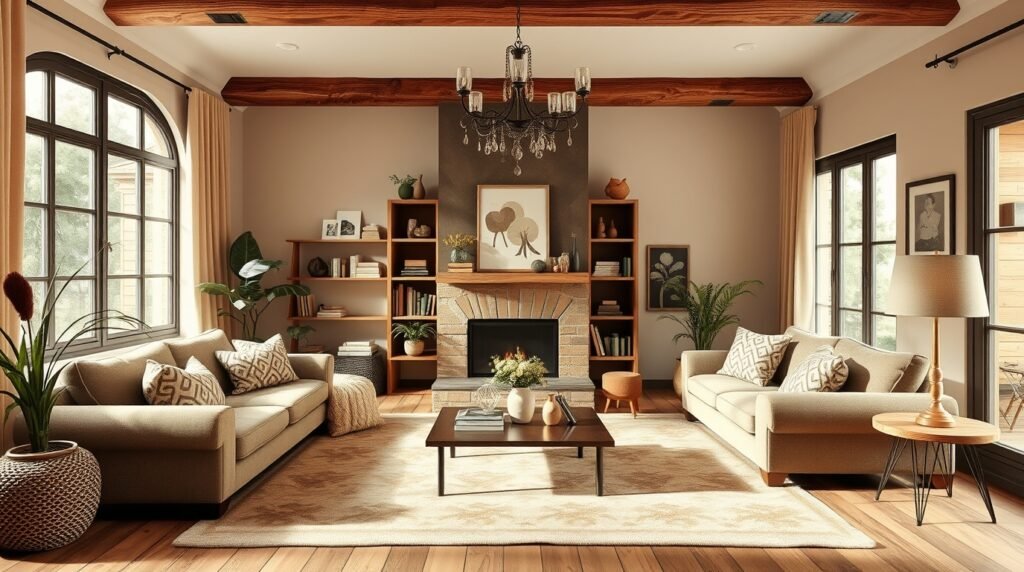
Creating a Maximalist Living Space
Want to make your home full of life and character? Try creating a maximalist living space. It’s all about bold decor, mixing colors, and adding cool artifacts. This approach makes your home both lively and cozy.
Incorporating Bold Accents and Textures
Maximalism shines by using bright accents and lots of textures. Designers say to mix different patterns like checks and stripes for excitement. By adding things like vintage fabrics and patterned tiles, you bring in fun and charm. Putting various tile designs in the kitchen, for example, catches the eye.
Also, combining deep colors, such as brick red for shelves, with playful wallpapers makes small places pop. This makes every corner feel special.
With maximalism, the only rule is comfort, which allows for the free layering of textures and colors.
Telling a Story Through Unique Pieces
In a maximalist home, every piece has a story. From old treasures to new art, these items create interesting spots that show off who you are. Think about setting up a gallery wall with different frames. It becomes a key part of your space like iconic farmhouse shiplap.
Also, using shelves on walls makes room for more of your stuff without cluttering the floor. It’s important to keep a good balance. Your furniture should not only look good but also be useful. Start with decorating tables with items that are both pretty and practical. This keeps the maximalist charm without losing order.
Finding a Balance Between Minimalism and Maximalism
Many homeowners today blend minimalist and maximalist styles for a balanced home design. They aim for a living space that feels simple yet bold. Finding the right mix can create a space that feels both inviting and expressive.
Many people appreciate a blend of both minimalist and maximalist elements in their decor, and this combination is becoming increasingly popular. Homeowners are finding creative ways to balance simplicity with bold, expressive touches, achieving a design that offers the best of both styles.
Minimalist design emphasizes a “less is more” approach, focusing on functionality and decluttered spaces.
To make a balanced home design, mix minimalist and maximalist styles. Use clean lines and functional items to keep spaces clear of clutter. Then, add expressive decor pieces for boldness.
Some minimalists enhance their spaces by incorporating bold decor, adding character while maintaining simplicity. At the same time, many maximalists feel their decor reflects their personality and individuality. This shift highlights a growing preference for more personal and statement-making designs in home decor.
Key styles that embrace minimalism include Midcentury Modern, Scandinavian, and Asian Zen/Feng Shui, whereas Art Deco, Bohemian, and Eclectic styles exemplify maximalism.
By mixing styles thoughtfully, you can create a home with minimalism’s calm and maximalism’s flair. Try starting with a minimalist base and adding colorful, intricate elements. This way, your home will have personality and simplicity.
Indeed, many individuals have tried mixing these styles in their homes. It can be tough to get the balance right. Yet, those who do often enjoy a more serene and pleasing home environment, regardless of style.
Incorporating Minimalist and Maximalist Elements in Different Rooms
To mix minimalism and maximalism in your home, think about each room’s function. Balance the simple and bold by combining clean lines and muted colors with bright decorations and varied textures. This approach makes rooms both pretty and useful.
Minimalist Bedrooms: Restful and Uncluttered
Minimalist bedrooms are quiet places without too much stuff. They have simple lines and soft colors to help you relax. Choose furniture that hides things away, like built-in closets, to keep the room open and tidy. A simple bed and neat side tables add to the calmness.
Maximalist Offices: Rooms Full of Inspiration
Make your office a place that sparks ideas with lots of maximalist touches. It should have bold colors, different fabrics, and unique items. Add interesting materials like green marble or bright woods to stand out. Yet, make sure your furniture is both good-looking and useful for work.
Painting walls and ceilings one bold color can tie everything together. Use similar colors for patterns to keep things lively without overdoing it. Add some bold art and special lights to mix in fun with the simple parts, making a place where you can be creative and productive.
Design Inspiration from Notable Designers
In the interior design world, top designers merge simple and complex styles to make unique, luxurious spaces. Laurence Llewellyn Bowen and Pamela O’Brien stand out. They show how design can uplift and transform your home décor.
The Work of Laurence Llewellyn Bowen
Laurence Llewellyn Bowen shines in the world of bold design. He decorates homes with eye-catching details, deep colors, and a flair for drama. Bowen mixes lavish fabrics and striking patterns to make lively, unforgettable areas.
He draws on history and storytelling in his designs. This makes spaces not just beautiful but full of character and life.
Pamela O’Brien’s Design Philosophy
Pamela O’Brien prefers a simpler, elegant style. She highlights the beauty of simplicity and clean design. Her work is all about calm and sophisticated living spaces.
Using soft colors and natural materials, she makes each part of a room meaningful. O’Brien’s designs show how powerful a minimalistic approach can be.
Whether you love boldness or simplicity, Laurence Llewellyn Bowen and Pamela O’Brien can inspire you. Their work demonstrates how to blend different styles to reflect your personal taste.

